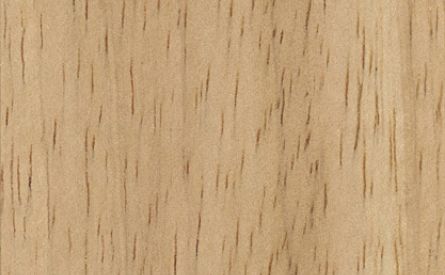Rubberwood
Hule / Hevea brasiliensis

Local Names
Distribution & Tree
Rubber is a fast-growing tree native to the Amazon Basin, but today is widely planted across tropical America, Southeast Asia and West Africa for latex production. Rubber in the wild grows in the tropical evergreen rainforest of the Amazon Basin, often in periodically flooded areas with the largest trees found on the well-drained plateau. In its natural state, trees may reach heights of 35 meters with large cylindrical trunks. Rubber trees on plantations reach a diameter of about 50 cm, usually with a short bole with a pronounced taper. Central America is host to a native species of hule (Castilla elastica) that was utilized by indigenous groups in the pre-Hispanic period for sporting balls and impermeable sheets and exported during the colonial period but isn’t commercially planted today.
Wood Appearance
Processing Properties
Strength & Durability
Rubberwood is equal to or stronger than Pinus svlvestris in all mechanical properties. The timber is perishable and stains readily when untreated and is susceptible to borer, termite and powder-beetle attack. It requires treatment which is readily accomplished, including with a hot and cold bath system.
Wood Uses
Ecological & Social Importance
| Reference Species | ||||
| Technical Characteristics | Rubberwood | American Elm | Red Cedar | |
| Density | kg/m3 | 592 | 560 | 530 |
| Janka Hardness | kgf | 451 | 376 | 408 |
| Bending Stiffness (Modulus of Elasticity) | GPa | 9.1 | 9.2 | 6.1 |
| Bending Strength (Modulus of Rupture) | MPa | 71.9 | 81.4 | 60.7 |
| Crushing Strength | MPa | 42.1 | 38.1 | 41.5 |
| Shrinkage, Radial | % | 2.3% | 4.2% | 3.1% |
| Shrinkage, Tangential | % | 5.1% | 9.5% | 4.7% |
| Shrinkage, Volumetric | % | 7.5% | 14.6% | 7.8% |
| T/R Ratio | 2.2 | 2.3 | 1.5 | |
| Values determined at 12% humidity - Provided for reference only | ||||
|---|---|---|---|---|
DENSITY
JANKA HARDNESS
BENDING STIFFNESS
BENDING STRENGTH
CRUSHING STRENGTH
SHRINKAGE
Values are for reference only and cannot be guaranteed. Wood is a natural material and physical and mechanical properties may vary depending on age, genetics, and other factors. We encourage customers to consult the references provided in the bibliography. For further explanations of wood’s key technical characteristics, an excellent resource is the Wood Database with articles on Density (average dried weight); Janka hardness; Elastic Modulus; Rupture Modulus; Crushing Strength; Radial, Tangential and Volumetric Shrinkage.






